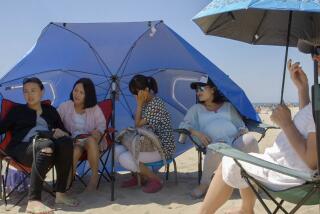Op-Ed: Asian women fought the West’s slave trade. And then they were written out of history
It was nearly dusk on Dec. 14, 1933, when a Chinese teen named Jeung Gwai Ying fled from a hairdresser’s shop to a “safe house” in San Francisco’s Chinatown. Trafficked from China and forced into prostitution, Jeung sought freedom for herself and her unborn child. She was greeted by Tien Fuh Wu, a former slave who’d become a key staffer at the home. In Cantonese, Wu asked the teen to tell her story. Later, Wu would provide support for Jeung as she testified in court against her traffickers, who were convicted.
In the early decades of the 20th century, Wu was a key player in the fight against sex trafficking, a pervasive form of slavery in the West. But like many other Asian activists and anti-slavery pioneers, her name and story have been all but erased from most contemporary histories, in favor of stories that cast her white colleagues — women and men — in heroic, larger-than-life roles.
Most accounts of the rescue home at 920 Sacramento St. focus on the work of its longtime superintendent, Donaldina Cameron, a white Presbyterian missionary. As the youngest daughter of a Scottish sheep rancher, she had lived on a 19,000-acre sheep ranch in the San Gabriel Valley in the 1880s before moving to San Francisco to work at the rescue home in 1895. Cameron was a tall, auburn-haired woman with a Scottish lilt who fascinated headline writers and the public alike. She regularly staged dramatic rescues of so-called slave girls from their owners, in her Victorian era’s parlance.
Cameron’s courageous contributions were impressive without doubt, but she was only one character in this tale of sex, violence and resilience. For decades, Wu was in many ways her “right-hand woman” — helping Cameron run the home, communicating with the trafficked women in Cantonese, and campaigning and advocating for them in court and elsewhere. Wu and other Asian staffers made Cameron’s work possible.
While researching my book about the San Francisco rescue home, I came to realize just how pervasive this “white savior” narrative is in the retelling of this horrifying chapter of Asian American history. In the archival material, press accounts and biographies I came across, the stories of white Christian women were invariably placed front and center, with barely a mention of their Asian colleagues who often did much of the work behind the scenes.
This is a pervasive problem in many historical narratives — making the white experience the central theme in accounts of people of color. The problem is compounded by widespread racist cultural stereotypes from the era that persist today that paint Asian women as either passive helpers or tragic victims, rather than as radicals or crucial central figures. I tried to take particular care to correct this imbalance — not just to tell the stories of Chinese activists who have been largely erased from mainstream history — but also give them the prominence they deserve.
These women were pioneers in what is now called the anti-human trafficking movement. Through their efforts, they touched an enormous number of lives throughout California and the nation. An estimated 2,000 to 3,000 residents passed through San Francisco’s Presbyterian Mission Home between the time it opened in 1874 and the mid-1930s. Cameron, Wu and other staffers from the home crisscrossed the state and the country for decades, aiding vulnerable women and speaking out against the slave trade.
This extraordinary and often cash-strapped band of activists managed to disrupt the lucrative business of human trafficking between China and America for more than half a century.
Wu’s story is particularly fascinating. She arrived at the rescue home in San Francisco about 15 months before Cameron. By Wu’s own account, she had been sold by her father in China to pay off his gambling debts. When she was about 8 years old, she traveled by steamer to San Francisco, where she worked as a mui tsai, or child servant. After her owner abused her, authorities became aware of her plight and brought her to the rescue home.
Regarded as a bright and precocious child, Wu learned to read and write English at the home and eventually attended an elite boarding school in Philadelphia and a Bible college in Toronto. Upon graduating, she returned to China with the hope of locating her family. Having no luck, she returned to the mission home, where she worked for decades as a translator and managed the large group home that had as many as 60 girls and women — mainly of Asian descent — living there at any one time.
When the home would receive a message that a child or young woman was in danger or distress, Wu or another Chinese rescue worker would go with Cameron to the apartment or brothel often accompanied by a police officer or private guard. The Chinese staffer would often make the first approach, asking to be let in. If the doorkeeper refused, the officer or guard would try to push their way in, even if it meant breaking down the door.
The work undertaken by the Mission Home staff often included repeated court appearances, since traffickers often fought to reclaim what they regarded as their human property. Wu served as a translator many times over the years, in court and in dealings with immigration officials.
My research also uncovered the relatively unknown stories of what happened to many of the girls and women who escaped sex slavery and other forms of subjugation to find their freedom. They were far from passive victims. Many chose to continue the fight against slavery by working as translators and running the home on a day-to-day basis. One former resident, Yamada Waka, set up a refuge in Japan modeled on 920 Sacramento St. for Japanese women forced into prostitution.
One of the more poignant moments during my research occurred at Evergreen Cemetery on the Eastside of Los Angeles. There, in the Cameron family plot, was a modest marker for Wu. Her burial place speaks to her importance in Cameron’s life — and to the pivotal role she played in their decades-long battle against sex trafficking.
Julia Flynn Siler is the author of “The White Devil’s Daughters: The Women Who Fought Slavery in San Francisco’s Chinatown.”
More to Read
A cure for the common opinion
Get thought-provoking perspectives with our weekly newsletter.
You may occasionally receive promotional content from the Los Angeles Times.






